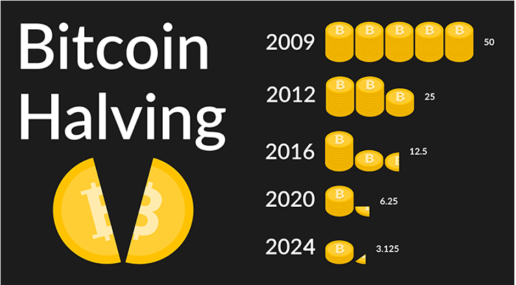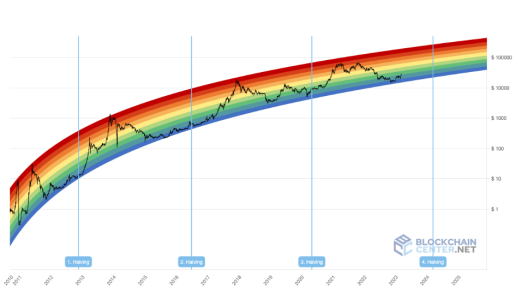The Bitcoin blockchain comprises a globally distributed set of mining nodes, or miners, responsible for securing the network by validating transactions and producing new bitcoin blocks. The winning miner of each block earns a coin-based transaction, also known as a block reward (newly mined BTC), and bitcoin transaction fees when network-wide consensus is met.
Below, we will discuss the Bitcoin halving cycle and its implications for the next Bitcoin halving date on the networks' participants.
What is Bitcoin Halving and Why is it Important?
Bitcoin Halving, also known as the "Halvening," is where block rewards for Bitcoin miners are cut in half. This phenomenon was programmatically built into the Bitcoin blockchain at inception and takes place every 210,000 blocks, or approximately every four years. For perspective, there are ~144 blocks mined every 24 hours, or 6.25 every ~10 minutes.
The pseudonymous creator of Bitcoin, Satoshi Nakamoto, decided when halving occurs to maintain Bitcoin's scarcity and control the rate at which new coins are introduced into circulation. There is only 21 million bitcoin in existence and approximately 19.32 million have been mined (~92%).
This means that there will be less BTC mined and put into circulation as bitcoin rewards are reduced from 6.25 BTC to 3.125 BTC per block in 2024.
A Brief History of Bitcoin Halving Dates

Source: Cryptoanswers
The first Bitcoin halving took place on November 28, 2012 (Block 210,000), which reduced mining rewards for the first time from 50 bitcoins per block to 25. Bitcoin was relatively new at that point with very few applications available.
The second halving event (Block 420,000) occurred on July 9, 2016, reducing mining rewards from 25 to 12.5. This was when new exchanges like Coinbase, Bitstamp, and Kraken were establishing themselves in the market, and businesses like Overstock.com, Expedia, and Microsoft started accepting Bitcoin as a payment method. Bitcoin ATMs were beginning to appear in cities worldwide.
The last Bitcoin halving event (Block 630,000) occurred on May 11, 2020, cutting mining rewards from 12.5 bitcoins to 6.25 bitcoin per block. Since the first halving, much development has happened in the blockchain ecosystem, including the introduction of decentralized finance (DeFi), non-fungible tokens (NFTs), publicly traded Bitcoin mining companies, and various digital wallet offerings, to name a few.
Speculating on Bitcoin Price Movements Following Halving Events

Source: Chart by Blockchaincenter
When considering Bitcoin's price action, it's also important to consider its relationship to mining profitability. Miners' profitability has historically relied heavily on the price appreciation of BTC due to modest bitcoin transaction fees. As profitability decreases, miners are less interested in selling BTC at a loss, slowing sell-side pressure. However, last year's volatility has shown that some mining operators had no choice but to sell their BTC at unattractive prices to cover overhead expenses as energy costs proliferated.
There are also debates about Bitcoin price correlating with hashrate. The hashrate refers to the computational load miners require to validate transactions on the Bitcoin network. A higher hashrate corresponds to increased difficulty in producing a hash resulting from increased competition, implying a more secure network.
Although nearly impossible to predict how BTC will react to the next cycle, the price of Bitcoin has been known to trend upward following a halving event. The argument assumes the demand for BTC remains constant or grows as less BTC is brought into circulation. In theory, these supply/demand dynamics should create upward price pressure and display some sort of impact on the cryptocurrency's price.
So is Bitcoin's Next Halving Good or Bad, and for Whom?
It's important to remember that it takes two to tango. Miners are incentivized to secure the network by earning Bitcoin block rewards and fees, presuming that they appreciate in value. Investors are incentivized by profitable price behavior (long or short).
So how does Bitcoin halving impact the two?
Bitcoin halvings help maintain scarcity by slowing down the distribution of new coins into circulation, which could preserve Bitcoin's value. It can also stabilize prices by reducing miners' sell-side pressure and encourage mining operators to sustain profits by bringing innovative solutions and increasing efficiency. Historically, a positive relationship has existed between price action leading up to and following a bitcoin halving. Additionally, it can improve network security due to the increased difficulty of a 51% attack. These are some benefits that could attract more investors and increase demand.
However, Bitcoin halving could have some downsides. Several examples include reducing block rewards and unpredictable energy costs, which could affect miner profitability. If the cost to operate exceeds the incentives, it could result in more undersized mining operators exiting the network, increasing mining centralization. This can be exacerbated if bitcoin fees need to be more substantial to incentivize miners. Also, unintended consequences could be difficult to predict, like a sudden drop in network hash power that could make the network more vulnerable to attacks.
What’s different about Bitcoin's Next Halving? Everything You Need to Know
The Bitcoin and broader blockchain ecosystem has matured significantly since the last halving.
There have been many reputable institutions that have adopted or discussed adopting Bitcoin and blockchain technology. Fidelity, a $3.6 trillion asset manager that is arguably the largest brokerage firm by active brokerage accounts, recently opened up Bitcoin and Ethereum trading to retail accounts, and the list is growing. In recent years, there has been a significant expansion in the number of commercial-grade mining operators, blockchain infrastructure providers, and even countries that have enacted legislation recognizing Bitcoin as a legal tender.
The Bitcoin ecosystem, in particular, has seen healthy growth and development. The Lightning Network has grown its payments capacity from $8.1 million in May 2020 to nearly $150 million today. Stacks, a Bitcoin layer for smart contracts that settles on the Bitcoin blockchain, grew its market capitalization from $40 million to $1.5 billion during the same period.
The rise of Bitcoin Ordinals has generated a surge of enthusiasm in the Bitcoin community, particularly for Bitcoin NFTs. Leading NFT collections have joined the platform, resulting in heightened activity and demand for Bitcoin block space.
Consequently, miners have experienced a substantial boost in revenue from bitcoin fees. This activity has the potential to alleviate concerns over decreasing block rewards and establish a more sustainable fee market.
Bitcoin Halving Countdown
There are approximately 403 days until the fourth halving event where block rewards will get cut in half from 6.25 bitcoin to 3.125 in March 2024.
With the upcoming 2024 halving, it's clear that there are compelling factors. Retail and institutional interest will likely persist, leading to further advancements and innovations within the industry while developers work to enhance the user experience.
The combination of renewed interest in NFTs, the increase in the Lightning Network's capacity, the development of Stacks and their upcoming Bitcoin peg, sBTC, and recent advancements in Bitcoin rollups all indicate that Bitcoin's ecosystem is poised for growth.

